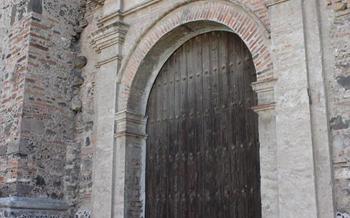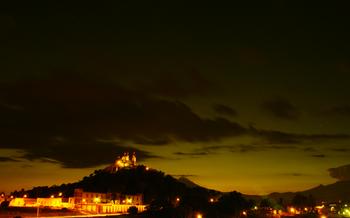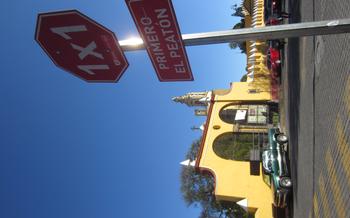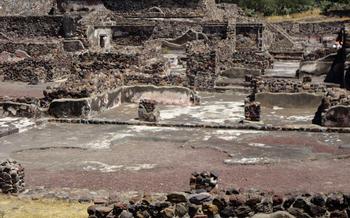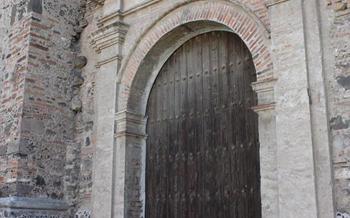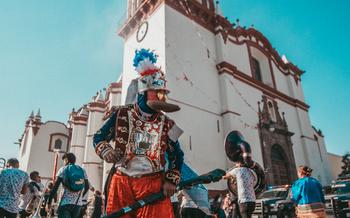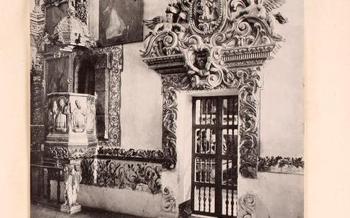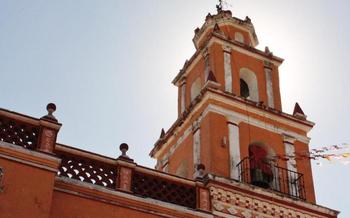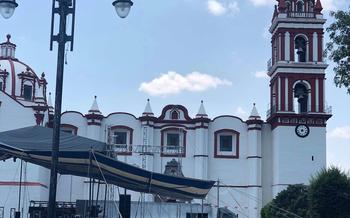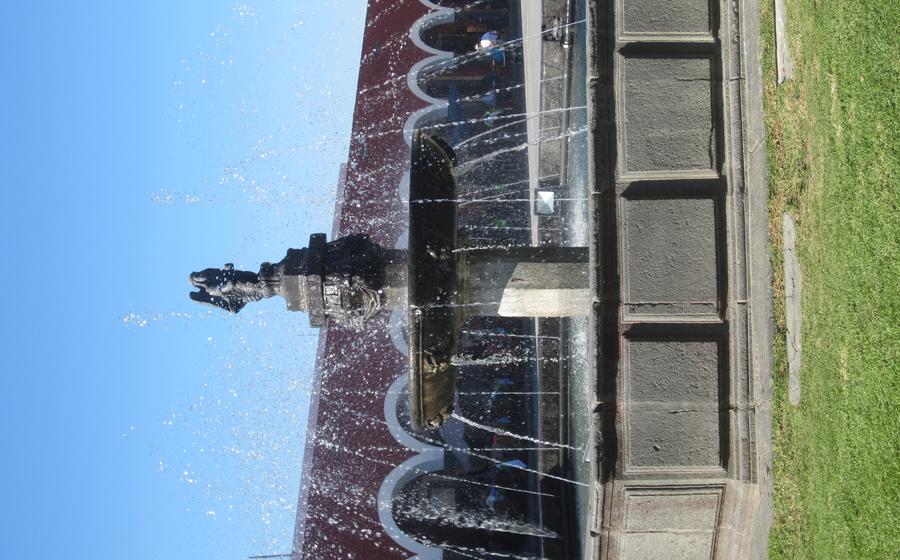
Capilla de Santa María Xixitla
- A Pre-Hispanic Gem in Cholula's Heart
- Unveiling the Legend of Quetzalcoatl
- Stepping into a Time Capsule
- Exploring the Chapel's Architectural Marvels
- Decoding the Murals' Enigmatic Tales
- A Photographer's Paradise
- A Glimpse into Ancient Engineering
- Unveiling the Secrets of the Murals
- A Must-Visit for History Buffs
- Insider Tip:
A Pre-Hispanic Gem in Cholula's Heart
Nestled within the heart of Cholula's archaeological site, the Capilla de Santa María Xixitla stands as a testament to the region's rich pre-Hispanic heritage. Constructed atop the remains of an ancient pyramid, the chapel holds immense historical significance, offering a glimpse into the religious and cultural practices of the pre-Columbian era. Its unique architectural style, circular design, and intricate stone carvings set it apart from other colonial-era churches in Mexico, making it a must-visit destination for history enthusiasts and travelers alike.
The chapel's location within the archaeological site further enhances its significance, as it provides a tangible connection to the ancient city of Cholula, once one of the largest and most important urban centers in Mesoamerica. Visitors can explore the surrounding ruins, including the Great Pyramid of Cholula, and gain a deeper understanding of the region's pre-Hispanic past.
Unveiling the Legend of Quetzalcoatl
The Capilla de Santa María Xixitla is steeped in the mystique and allure of the legendary figure Quetzalcoatl, the revered feathered serpent god of Mesoamerican mythology. According to legend, Quetzalcoatl descended from the heavens to Cholula, bringing with him knowledge, wisdom, and the arts of civilization. The construction of the chapel is said to be directly linked to the god's arrival, serving as a sacred space dedicated to his worship and veneration.
Symbolic representations of Quetzalcoatl adorn the chapel's iconography, paying homage to his divine presence. Murals depict the god in various forms, from a majestic serpent to a benevolent human figure. These artistic representations serve as a testament to the profound reverence held for Quetzalcoatl, whose teachings and guidance shaped the cultural and spiritual fabric of ancient Mexican society.
The enduring legacy of Quetzalcoatl's legend is deeply intertwined with the identity of Cholula. The city is fondly referred to as "Quetzalcoatl's Abode," and the spirit of the feathered serpent god continues to permeate the cultural landscape. The Capilla de Santa María Xixitla stands as a tangible reminder of this enduring legacy, inviting visitors to delve into the rich tapestry of myth, history, and spirituality that defines this sacred site.
Stepping into a Time Capsule
The Capilla de Santa María Xixit. Remarkably preserved over time, the chapel's interior walls are adorned with vibrant murals that offer a glimpse into ancient rituals, ceremonies, and everyday life. These murals, painted in vivid colors and intricate detail, capture the essence of pre-Hispanic culture and provide valuable insights into the beliefs and practices of the people who inhabited this region centuries ago.
The chapel's murals depict a variety of scenes, including religious ceremonies, processions, battles, and mythical tales. They showcase the artistry and storytelling skills of the ancient inhabitants of Cholula. Through these murals, we can witness the daily lives of the people, their customs, and their deep connection to the natural world.
The Capilla de Santa María Xixitla serves as a living time capsule, transporting visitors back to a bygone era. It offers a unique opportunity to delve into the rich cultural heritage of Mexico and gain a deeper understanding of the lives and beliefs of the ancient people who called this land home.
Exploring the Chapel's Architectural Marvels
The Capilla de Santa María Xixitla stands out for its unique circular design, a rarity in pre-Hispanic architecture. Its circular shape is believed to have been inspired by the ancient Mesoamerican ball game, which held ritual and symbolic significance. The chapel's walls are adorned with intricate stone carvings and sculptures, which depict a variety of deities, mythical creatures, and scenes from daily life. These carvings and sculptures provide valuable insights into the beliefs, customs, and artistic traditions of the ancient Cholutecans.
The circular layout of the chapel creates a sense of intimacy and spirituality. The interior space is dominated by a central altar, which is surrounded by a series of concentric rings. Each ring is decorated with different motifs and symbols, which represent various aspects of the pre-Hispanic worldview. The chapel's unique design and elaborate ornamentation combine to create a sacred and ceremonial space that is both awe-inspiring and deeply moving.
The chapel's architectural style and symbolism reflect the complex and sophisticated culture of the ancient Cholutecans. Its circular design, intricate carvings, and symbolic elements all contribute to its status as a masterpiece of pre-Hispanic architecture. The chapel is a testament to the skill and creativity of the ancient builders, and it continues to inspire and fascinate visitors to this day.
Decoding the Murals' Enigmatic Tales
The interior of the Capilla de Santa María Xixitla is adorned with stunning murals, adding to its cultural and historical significance. These murals, painted in vibrant colors, depict various deities, mythical creatures, and historical events, providing valuable insights into the beliefs and practices of pre-Hispanic societies.
The murals are a testament to the artistic prowess of the ancient inhabitants of Cholula. The intricate details, symbolism, and narratives woven into the paintings showcase the sophisticated storytelling techniques employed by pre-Hispanic artists. Each mural tells a unique tale, offering glimpses into the daily lives, rituals, and ceremonies of the ancient peoples.
For example, one mural depicts a procession of priests and dignitaries carrying offerings to the temple, while another showcases a battle scene between warriors adorned in elaborate headdresses and armor. The murals also feature representations of deities such as Quetzalcoatl, the feathered serpent god, and Tlaloc, the god of rain.
By studying these murals, researchers have gained valuable insights into the religious beliefs, social customs, and historical events of pre-Hispanic Cholula. The murals serve as a visual encyclopedia, providing a glimpse into the minds and hearts of the ancient inhabitants of this remarkable city.
A Photographer's Paradise
The Capilla de Santa María Xixitla is a visual delight, presenting a photographer's paradise with its picturesque setting and unique architecture. Its circular design, intricate stone carvings, and vibrant murals create a captivating canvas for photography enthusiasts. The play of light and shadow throughout the day casts an ethereal glow on the chapel, offering photographers endless opportunities to capture stunning images.
The interior of the chapel is a treasure trove of photographic opportunities, with its well-preserved murals depicting pre-Hispanic life and mythology. Each mural tells a story, inviting photographers to capture the essence of a bygone era. The vibrant colors and intricate details of the murals provide a feast for the eyes, making them a popular subject for photography.
To make the most of your visit as a photographer, it is advisable to come prepared with a wide-angle lens to capture the chapel's grandeur and a macro lens to capture the intricate details of the murals. Experiment with different angles and perspectives to create unique and captivating compositions. The best time to visit for photography is during the early morning or late afternoon, when the soft, golden light enhances the chapel's beauty.
The Capilla de Santa María Xixitla is a photographer's dream, offering a chance to capture the essence of ancient Mexico through its architecture, murals, and surroundings. Whether you are a professional photographer or an enthusiast, this chapel promises to be a rewarding destination for your photographic journey.
A Glimpse into Ancient Engineering
The Capilla de Santa María Xixitla stands as a testament to the ingenuity and engineering prowess of ancient builders. Constructed using local materials and traditional methods, the chapel has withstood the test of time, remaining remarkably intact despite centuries of exposure to the elements.
The chapel's construction techniques showcase the advanced engineering skills of the pre-Hispanic peoples. The use of stone vaults and arches, as well as the careful placement of stones to create a stable structure, demonstrates a deep understanding of architectural principles. The chapel's circular design, a rarity in pre-Hispanic architecture, further highlights the builders' creativity and innovation.
The use of local materials, such as stone and adobe, not only ensured the chapel's durability but also connected it to the surrounding landscape. The builders' ability to seamlessly integrate the chapel into its natural environment speaks to their respect for the land and their harmonious coexistence with nature.
The resilience and longevity of the Capilla de Santa María Xixitla serve as a reminder of the enduring legacy of ancient engineering. This remarkable chapel stands as a testament to the ingenuity and craftsmanship of the pre-Hispanic peoples, inviting visitors to marvel at their architectural achievements and gain a deeper appreciation for their rich cultural heritage.
Unveiling the Secrets of the Murals
The murals adorning the Capilla de Santa María Xixitla's interior are a testament to the artistic prowess and cultural significance of the ancient civilizations that inhabited the region. Created using various techniques, including fresco and tempera, these murals showcase a vibrant palette of natural pigments and dyes. The intricate iconography depicted in the murals reveals a rich tapestry of symbols, narratives, and mythological creatures, providing valuable insights into the beliefs and worldview of the pre-Hispanic people.
The murals feature a diverse array of subjects, including deities, historical events, and scenes from everyday life. Particularly noteworthy are the representations of Quetzalcoatl, the feathered serpent god, who is depicted in various forms and contexts, reflecting his central role in pre-Hispanic mythology. The murals also showcase scenes of rituals, ceremonies, and agricultural activities, offering a glimpse into the daily lives of the ancient inhabitants of Cholula.
The murals' remarkable preservation is a testament to the skill and dedication of the ancient artists who created them. Despite the passage of time and the effects of natural elements, the murals retain their vibrancy and detail, allowing visitors to appreciate their artistic and cultural significance. Through these murals, the Capilla de Santa María Xixitla offers a unique window into the past, inviting visitors to explore the rich artistic traditions and cultural heritage of pre-Hispanic Mexico.
A Must-Visit for History Buffs
For those with a passion for history and a desire to delve into the past, Capilla de Santa María Xixitla is an absolute must-visit destination. As a historical and cultural landmark of immense significance, it offers a unique opportunity to learn about pre-Hispanic history and culture firsthand. The chapel stands as a testament to the ingenuity, craftsmanship, and artistry of ancient civilizations. By exploring its intricate murals, architectural features, and symbolic elements, visitors can gain a deeper understanding of the beliefs, practices, and daily life of the people who inhabited this region centuries ago.
Furthermore, Capilla de Santa María Xixitla plays a vital role in understanding the development of Cholula and the surrounding region. Its existence sheds light on the cultural and historical significance of the city, providing valuable insights into the evolution of settlements, trade routes, and power dynamics in ancient Mexico. Researchers and scholars consider the chapel a treasure trove of information, offering clues to unravel the mysteries of the past. Its well-preserved state and the wealth of artifacts and iconography it contains make it an invaluable resource for advancing our knowledge of pre-Hispanic civilizations.
Insider Tip:
For an immersive and tranquil experience, visit the Capilla de Santa María Xixitla early in the morning or late in the afternoon to avoid the crowds. This will allow you to fully appreciate the chapel's serene atmosphere and capture stunning photographs without distractions.
After exploring the chapel, indulge in the flavors of traditional Mexican cuisine at one of the local restaurants or cafes in the vicinity. Savor the authentic taste of regional dishes and immerse yourself in the vibrant culinary scene of Cholula.
Don't miss the opportunity to discover other hidden gems within the Cholula archaeological site. Explore the nearby Templo de San Francisco Acatepec, with its impressive architecture and colonial-era charm. Admire the majestic Gran Pirámide de Cholula, the largest pyramid in the world by volume, and climb to its summit for breathtaking panoramic views of the city and the surrounding landscape.
Whether you're a history enthusiast, a culture seeker, or simply a traveler with a curious mind, the Capilla de Santa María Xixitla and the Cholula archaeological site offer a treasure trove of experiences waiting to be uncovered. Immerse yourself in the rich tapestry of the past and create unforgettable memories in this captivating corner of Mexico.
